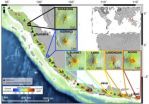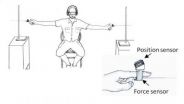Texas Biomed reports faster, more economical method for detecting bioterror threats
2012-11-05
(Press-News.org) Texas Biomedical Research Institute scientists in San Antonio have developed a faster, less expensive route to screen suitable tests for bioterror threats and accelerate the application of countermeasures.
The new process screens for pairs of affinity reagents – molecular magnets that bind to and hold on to their targets, be they toxins, viruses or bacteria. That will enable countermeasures to be selected and utilized much faster than the current practice.
"Using crude extracts from E. coli, the workhorse bacterium of the biotechnology laboratory, the new route bypasses the need for purification and complex equipment, enabling screening to be performed in under an hour," said Andrew Hayhurst, Ph.D., a Texas Biomed virologist.
Normally, he said, such screening requires sophisticated costly equipment to purify and analyze the affinity reagents. Such analysis becomes a huge burden when hundreds of reagents need to be checked and can take weeks to months.
The process – funded primarily by Texas Biomed and the San Antonio Area Foundation, and in part by the Defense Threat Reduction Agency and the National Institutes of Health (NIH) – was described online in the November 5, 2012 issue of Nature Publishing Group's Scientific Reports.
"We need an inexpensive route to screen libraries of affinity reagents. It had to be simple and self-contained as we eventually needed it to work in the space-suit lab or hot zone," said Hayhurst.
His surprisingly simple scheme allows scientists to make stop-gap tests to any given biological threat in a matter of days, with the screening step completed in an hour. The goal now is to speed up the entire process to work within a single day.
Hayhurst initially developed the pipeline using llama antibodies as the affinity reagents to botulinum neurotoxins, known as the world's most poisonous poisons – 100 billion times more toxic than cyanide and handled in a specialized biosafety cabinet at biosafety level 2. Satisfied that the system was working, he then took it into the biosafety level 4 laboratory with his assistant, Laura Jo Sherwood, and they generated a stop-gap test for Ebolavirus Zaire in days. This virus has been shown to be 95 percent lethal in outbreak settings and with no vaccine or therapeutic it is a risk to the U.S. through importation. Botulinum neurotoxins and Ebolavirus are among a handful of threats now categorized as Tier 1 agents, presenting the greatest risk of deliberate misuse with the most significant potential for mass casualties or devastating effects to the economy, critical infrastructure; or public confidence.
"Being able to respond quickly to known biological threats will better prepare us for combating emerging and engineered threats of the future," Hayhurst said. "However, the great thing about this test pipeline is that it can be applied to almost any target of interest, including markers of diseases like cancer."
Texas Biomed has applied for a patent on the process. It potentially could be licensed to companies for developing diagnostics to specific medical conditions, tests for environmental monitoring, or to accelerate in-house research programs.
###
Texas Biomed, formerly the Southwest Foundation for Biomedical Research, is one of the world's leading independent biomedical research institutions dedicated to advancing global human health through innovative biomedical research. Located on a 200-acre campus on the northwest side of San Antonio, Texas, the Institute partners with hundreds of researchers and institutions around the world, targeting advances in the fight against AIDS, hepatitis, malaria, parasitic infections and a host of other infectious diseases, as well as cardiovascular disease, diabetes, obesity, cancer, psychiatric disorders, and problems of pregnancy. NIH support included award R21 AI73394-2 and construction grant C06 RR12087.For more information on Texas Biomed, go to www.TxBiomed.org, or call Joe Carey, Texas Biomed's Vice President for Public Affairs, at 210-258-9437.
ELSE PRESS RELEASES FROM THIS DATE:
Study: New tool helps doctors predict heart attack patients at risk for repeat hospitalization
2012-11-05
SALT LAKE CITY – Some heart attack patients end up back in the hospital just weeks after going home. It can happen for a variety of reasons, but doctors haven't had a reliable way to predict which patients will return — until now.
Thanks to a new tool developed by researchers at the Intermountain Medical Center Heart Institute in Salt Lake City, physicians now have a tool to help identify these patients. This will enable physicians to re-evaluate their treatment plans in the hopes of preventing future admissions.
"If you can identify these patients, you have a better ...
Lifetime risk of developing cardiovascular disease substantial
2012-11-05
CHICAGO – Even in men and women with an optimal cardiovascular disease (CVD) risk factor profile, the lifetime risk estimate for CVD is greater than 30 percent, and is more than 50 percent for men and women overall, according to a study appearing in November 7 issue of JAMA, a theme issue on cardiovascular disease. The study is being released early online to coincide with the American Heart Association's Scientific Sessions.
"To date, there have been no published data on the lifetime risk for total CVD (including coronary heart disease [CHD], atherosclerotic and hemorrhagic ...
Daily multivitamin use among men does not reduce risk of major cardiovascular events
2012-11-05
CHICAGO – In a randomized study that included nearly 15,000 male physicians who were middle-aged or older, daily multivitamin use for more than 10 years of treatment and follow-up did not result in a reduction of major cardiovascular events, heart attack, stroke, or death from cardiovascular disease, according to a study appearing in November 7 issue of JAMA, a theme issue on cardiovascular disease. The study is being released early online to coincide with its presentation at the American Heart Association's Scientific Sessions.
"Despite uncertainty regarding the long-term ...
Risk of fatal coronary heart disease higher among black men
2012-11-05
CHICAGO – In an examination of the incidence of coronary heart disease (CHD) in the U.S. by race and sex, black men and women had twice the rate of fatal CHD compared with white men and women, with this increased risk associated with a greater prevalence of CHD risk factors, according to a study appearing in November 7 issue of JAMA, a theme issue on cardiovascular disease. The study is being released early online to coincide with the American Heart Association's Scientific Sessions.
"Although mortality rates for acute myocardial infarction [MI; heart attack] and coronary ...
Study finds high prevalence of major cardiovascular disease risk factors among US Hispanic adults
2012-11-05
CHICAGO – In a study that involved more than 16,000 Hispanic/Latino men and women living in the United States, the prevalence of major cardiovascular disease (CVD) risk factors was high and varied markedly across different background groups; and those born in the U.S. were more likely to report a history of coronary heart disease and stroke and to have multiple CVD risk factors, according to a study appearing in November 7 issue of JAMA, a theme issue on cardiovascular disease. The study is being released early online to coincide with the American Heart Association's Scientific ...
Taking the 'pulse' of volcanoes using satellite images
2012-11-05
MIAMI – November 5, 2012 -- A new study by scientists at the University of Miami (UM) Rosenstiel School of Marine & Atmospheric Science uses Interferometric Synthetic Aperture Radar (InSAR) data to investigate deformation prior to the eruption of active volcanoes in Indonesia's west Sunda arc. Led by geophysicist Estelle Chaussard and UM Professor Falk Amelung, the study uncovered evidence that several volcanoes did in fact 'inflate' prior to eruptions due to the rise of magma. The fact that such deformation could be detected by satellite is a major step forward in volcanology; ...
Hydro-fracking: Fact vs. fiction
2012-11-05
Boulder, CO, USA – In communities across the U.S., people are hearing more and more about a controversial oil and gas extraction technique called hydraulic fracturing – aka, hydro-fracking. Controversies pivot on some basic questions: Can hydro-fracking contaminate domestic wells? Does it cause earthquakes? How can we know? What can be done about these things if they are true? A wide range of researchers will address these and related critical questions at the GSA Annual Meeting this week.
"When people talk about contamination from hydraulic fracturing, for instance, ...
Field geologists (finally) going digital
2012-11-05
Boulder, CO, USA – Not very long ago a professional geologist's field kit consisted of a Brunton compass, rock hammer, magnifying glass, and field notebook. No longer. In the field and in the labs and classrooms, studying Earth has undergone an explosive change in recent years, fueled by technological leaps in handheld digital devices, especially tablet computers and cameras.
Geologist Terry Pavlis' digital epiphany came almost 20 years ago when he was in a museum looking at a 19th-century geology exhibit that included a Brunton compass. "Holy moly!" he remembers thinking, ...
Learning a new sense
2012-11-05
Rats use a sense that humans don't: whisking. They move their facial whiskers back and forth about eight times a second to locate objects in their environment. Could humans acquire this sense? And if they can, what could understanding the process of adapting to new sensory input tell us about how humans normally sense? At the Weizmann Institute, researchers explored these questions by attaching plastic "whiskers" to the fingers of blindfolded volunteers and asking them to carry out a location task. The findings, which recently appeared in the Journal of Neuroscience, have ...
Cystic kidney growth curbed
2012-11-05
Autosomal-dominant polycystic kidney disease (ADPKD) is one of the most common genetic disorders, affecting one in every 1,000 people and responsible for up to ten percent of patients on dialysis worldwide. The disease is characterized by the development of cysts that lead to progressive kidney failure and necessitate dialysis or a kidney transplant in most patients aged around fifty. Moreover, the persistent cyst growth causes high blood pressure and painful complications. Although we have known about the disease for over a century and its genetic basis for almost 20 years, ...

